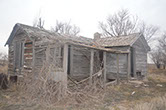
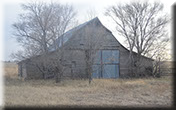
PHILLIPS COUNTY
Colorado
125 Years of History
With humble beginnings on the flat, treeless plains of northeast Colorado, Phillips County celebrates its 125th anniversary Thursday, March 27, while proudly looking back to its history from 1889 to 2014.
This roughly 688-square-mile chunk of land was once home to buffalo and then cattle herds, which roamed the prairie as the Colorado Territory was introduced in 1861 and Weld County, one of the original 17 Colorado counties, encompassed the entire northeast corner.
Colorado became a state and entered the union Aug. 1, 1876.
Homesteaders began to settle in the Frenchman Creek area in the mid-1880s to claim free land from the United States government through the Homestead Act of 1865. They dotted the prairie with the establishment of their sod houses and began to fence off their land.
Some have observed that this region was settled later than others nearby, probably because there are no rivers.
Logan County was created from a legislative act in February 1887, taking over the northeast corner of Colorado and again encompassing present-day Phillips County.
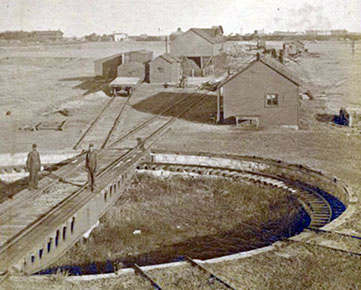
The Burlington-Missouri Railroad was instrumental in bringing homesteaders to Phillips County. The rail was laid in northeast Colorado in 1887 with a town site every 8-10 miles—Amherst, Holyoke, Paoli and Haxtun. The round house is pictured at the Holyoke train depot.
March 27, 1889: Phillips County celebrates 125th
WRITTEN BY DARCI TOMKY
WEDNESDAY, 26 MARCH 2014
Holyoke Enterprise March 27, 2014
Activity really began to take off in the region when the railroad rolled in. More homesteaders came when the Burlington-Missouri Railroad was built from Holdrege, Neb., to Sterling.
Construction commenced in the eastern part of the county in March 1887 and was completed to Sterling in September of that year.
The B&M Railroad provided a town site every 8 to 10 miles along the track. Thus Amherst, Holyoke, Paoli and Haxtun began to take shape and were named by officials of the railroad company.
On March 27, 1889, the eastern section of Logan County was divided to form Sedgwick and Phillips counties.
Phillips County was named in honor of R.O. Phillips, secretary of the Lincoln Land Company that laid out a number of towns in this part of the country, and the 125-year history of Phillips County began.

Agriculture has always been an important aspect of life in Phillips County, from its 1880s beginnings to today. Sod houses dotted the prairie as settler families took great care to farm the land and raise their livestock.
County government established
Election precincts were established in Phillips County July 8, 1889, and an election was called for in November.
A week later, county court convened with Judge J.H. Painter on the bench, commencing the judicial system of the county court in Phillips County.
In November 1889, the following county officers were elected:
Commissioners John C. Elder, M. Francis and Theodore Chalbery; Sheriff L.C. Witherbee; Clerk and Recorder C.E. McPherson; Judge James Glynn; Treasurer B.A. Hoskins; Assessor Otis Castetter; Superintendent of Schools Charles B. Timberlake; Surveyor William Lowe; and Coroner L.P. Lewis.
Holyoke was named the county seat.
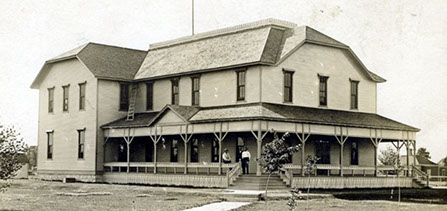
The former B&M eating house, originally located by the railroad depot, served as the Phillips County Courthouse from 1904 to 1935. When it was purchased for $3,000, it was moved to the current Phillips County square, the 200 block of South Interocean Avenue.
Three courthouses serve Phillips County
The first Phillips County Courthouse was a hotel building on the corner of Baxter Avenue and Denver Street, which was built by William Clemmons and rented to the county in 1889. The county bought the building in 1901 and continued to use it until 1904.
The famed B&M eating house located by the railroad depot became the second courthouse. Its doors were closed in 1899, and the county bought the building in 1904 for $3,000. At that point, the county also purchased the present courthouse block, the 200 block of South Interocean Avenue.
The former eating house was moved to this new courthouse square at a cost of $1,000 with a team of horses. The T-shaped building would serve as the courthouse for 31 years, with its polished floor of fine woods and a fireplace at one end.
In 1924, a one-fourth mill levy was created to finance a new courthouse, but in 1931, due to the economic situation, the commissioners discontinued the expense to taxpayers. The fund, however, grew to $27,319.17.
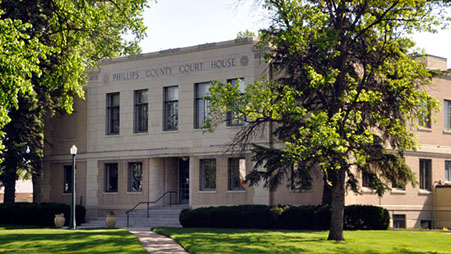
The current Phillips County Courthouse was built in 1935-36, with Colorado Gov. Ed C. Johnson present for the laying of the cornerstone ceremonies on Sept. 13, 1935.

All materials contained on these pages are furnished for the free use of those engaged in researching their family origins. Any commercial use, without the consent of the host/author of these pages is prohibited. All images used on these pages were obtained from sources permitting free distribution, or generated by the author, and are subject to the same restrictions/permissions. All persons contributing material for posting on these pages does so in recognition of their free, non-commercial distribution, and further, is responsible to assure that no copyright is violated by their submission.
Last updated December 2018
